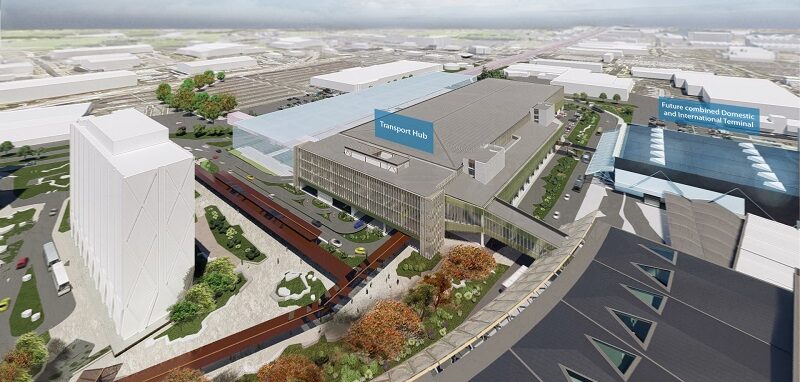Auckland Airport in New Zealand is to build a NZ$300m (US$188m) transportation center in front of its international terminal and automate its baggage handling process to reduce transfer times.
The Transport Hub, to be built in the footprint of the main international parking lot, has been designed to enable traffic to flow through its ground floor. Two traffic lanes will enter from Ray Emery Drive into an undercover pick-up and drop-off area with a short, covered walkway into the terminal. Built to double height, the ground floor of the four-story building will accommodate buses as well as cars; the upper floors will feature smart car parking, electric vehicle charging stations and office spaces, all designed to meet the Parksmart green parking building standard.
Along with the Transport Hub, the airport will invest NZ$185m (US$115m) in enabling works for its combined international and domestic terminal and other projects. Next month, the demolition of the international terminal’s eastern baggage hall will take place, making way for the development of a high-tech baggage handling system. Demolition of the eastern bag hall will be carried out alongside other works to clear the eastern airfield for the construction of a new domestic pier connected to the existing international terminal.
After three years of planning, Auckland Airport has progressed design work for an entirely new baggage handling process, introducing new technology and enhanced operations via an individual carrier system (ICS). The automated solution uses real-time data to track baggage as it journeys around back-of-house airport infrastructure. Bags are loaded into intelligent carrier trays tagged with radio frequency identification devices (RFID) that communicate their location as they travel through an elaborate conveyor network, speeding up the luggage journey between check-in and aircraft loading and reducing the risk of lost bags.
Carrie Hurihanganui, chief executive at Auckland Airport, said, “These building projects were important stepping stones toward the new combined domestic and international terminal, with major construction of the US$1bn project yet to begin. Timing will be guided by the pace of the recovery in aviation, with the total transformation project expected to take about five years to complete once major works begin.
“At Auckland Airport we are starting a new chapter of infrastructure investment that is all about building a better future for travelers from the moment they step foot on our precinct. The work we are doing now will clear the path for a new super-smart baggage system to be developed at Auckland Airport, which is all about speed and convenience for travelers while also ensuring their bags continue to arrive at the right place at the right time.”
Hurihanganui continued, “The airport strongly supports integrating different forms of transport to create more efficient and sustainable options. Recent developments included introducing new high-occupancy vehicle lanes through the airport precinct and cycling and walking paths, as well as road widening to support the new electric bus service from the airport to Puhinui Station. To provide for a future shift to mass rapid transit, the airport had taken steps to set aside land adjoining the new Transport Hub to provide for an integrated mass transit station, while the inner forecourt road will remain dedicated to buses and commercial transport.”

